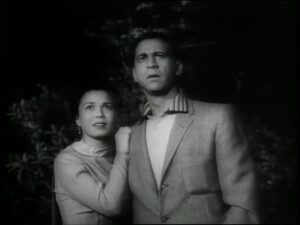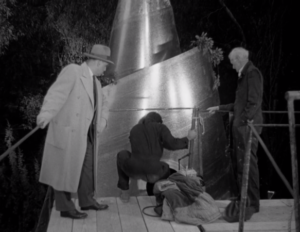A Low-Budget Nightmare That Stands the Test of Time

Science fiction horror films of the 1950s had a unique way of tapping into deep-seated fears. The Brain Eaters (1958) is a prime example of this. It blends psychological terror with a creeping sense of paranoia, making it a hidden gem of its era.
Directed by Bruno VeSota and produced on a modest budget, the film captures a haunting atmosphere that lingers long after the credits roll. If you love eerie, black-and-white sci-fi classics, this one deserves your attention.
The Plot: Parasitic Horror Unfolds

In a quiet Midwestern town, strange seismic activities raise concern. A group of scientists arrives to investigate but soon stumbles upon something far more terrifying. Mysterious creatures have emerged from underground fissures. They latch onto human hosts, burrowing into their brains and taking control. As the infection spreads, paranoia grips the town. Anyone could be a host. Anyone could be compromised. The scientists must act fast before the creatures spread beyond the town and threaten the world.
Cast and Characters
A great sci-fi horror film is nothing without a strong cast. Despite its low budget, The Brain Eaters boasts some memorable performances.
Ed Nelson as Dr. Paul Kettering
Ed Nelson plays the lead scientist, Dr. Paul Kettering. His character embodies the rational mind battling against an unknown, horrific force. Nelson was a familiar face in television and film, later becoming known for his roles in Peyton Place and Murder, She Wrote. His performance in The Brain Eaters is strong, despite the film’s constraints.
Alan Jay Factor as Glenn Cameron
Alan Jay Factor portrays Glenn Cameron, a man caught in the chaos of the parasitic invasion. His character undergoes a transformation as fear and uncertainty grip the town. Factor’s performance, though not as well-remembered as Nelson’s, helps ground the film’s tension and suspense.
Themes: Fear of the Unknown
One of the film’s strongest aspects is its ability to create a sense of paranoia. During the Cold War era, America was gripped by fears of infiltration and subversion. The Brain Eaters cleverly reflects these anxieties. The idea of losing control of one’s mind and body is deeply unsettling. This film plays on that fear masterfully.
Cinematography and Effects: A Noir-Like Atmosphere
Despite its low budget, the cinematography in The Brain Eaters is surprisingly effective. The black-and-white visuals enhance the eerie atmosphere. Shadows and dim lighting create a sense of dread. While the practical effects may seem simple today, they contribute to the film’s unsettling tone. The parasitic creatures themselves are depicted in a way that fuels the imagination rather than relying on elaborate effects.
The Influence of The Brain Eaters
Although it was not a major blockbuster, The Brain Eaters left a lasting impact on sci-fi horror. It influenced later films that explored mind control and paranoia, such as Invasion of the Body Snatchers and The Puppet Masters. The theme of unseen forces controlling humanity remains a staple in horror and science fiction storytelling.
Final Verdict: A Must-Watch for Classic Sci-Fi Fans
If you enjoy vintage horror and science fiction, The Brain Eaters is a must-watch. It delivers an eerie experience with a gripping atmosphere, even if its budget constraints are noticeable. Its themes remain relevant today, and its influence on later sci-fi horror films cannot be ignored. So, dim the lights, grab some popcorn, and prepare for a mind-invading experience you won’t forget.



